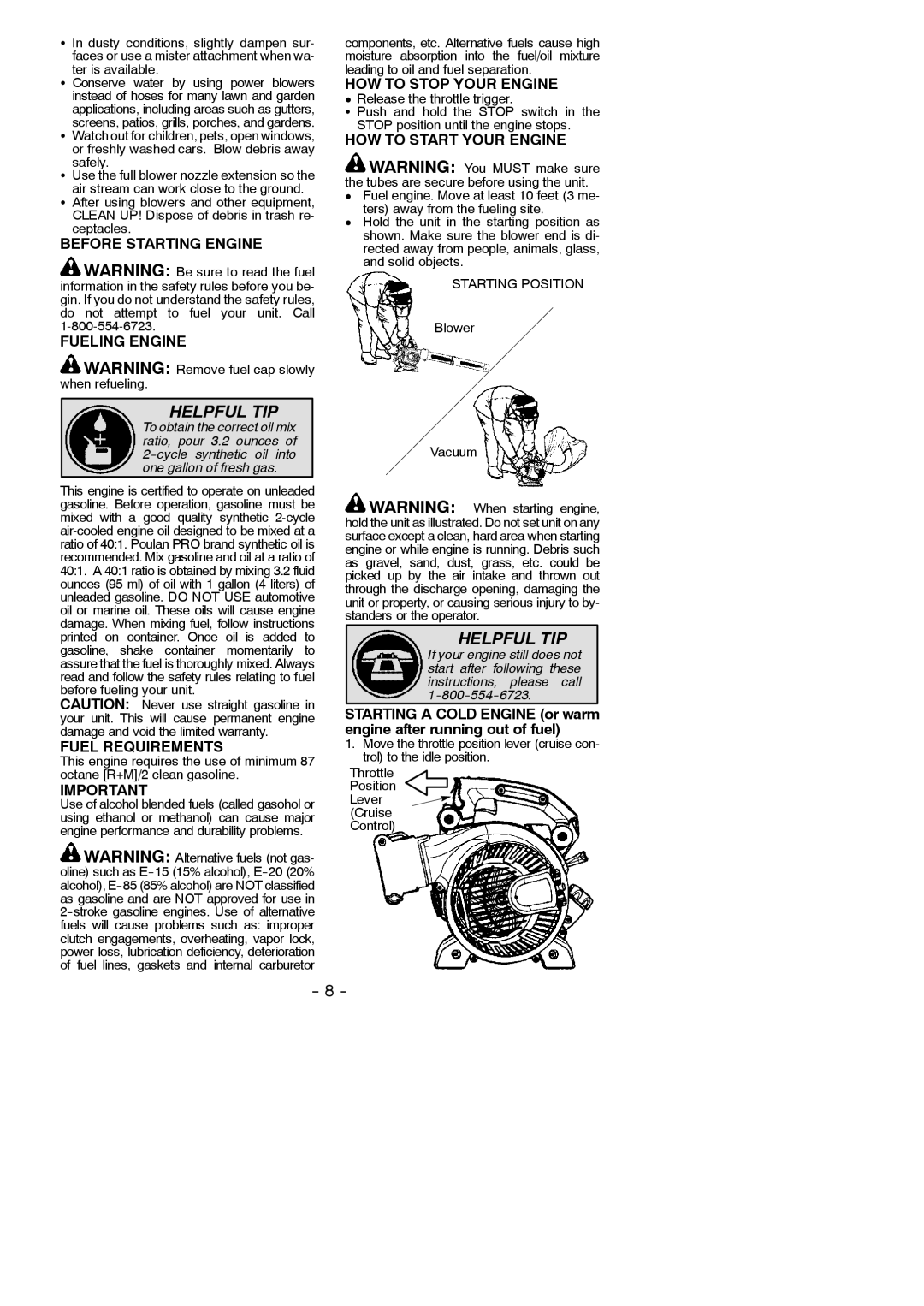
S In dusty conditions, slightly dampen sur- faces or use a mister attachment when wa- ter is available.
S Conserve water by using power blowers instead of hoses for many lawn and garden applications, including areas such as gutters, screens, patios, grills, porches, and gardens.
SWatch out for children, pets, open windows, or freshly washed cars. Blow debris away safely.
SUse the full blower nozzle extension so the air stream can work close to the ground.
SAfter using blowers and other equipment, CLEAN UP! Dispose of debris in trash re- ceptacles.
BEFORE STARTING ENGINE
![]() WARNING: Be sure to read the fuel information in the safety rules before you be- gin. If you do not understand the safety rules, do not attempt to fuel your unit. Call
WARNING: Be sure to read the fuel information in the safety rules before you be- gin. If you do not understand the safety rules, do not attempt to fuel your unit. Call
FUELING ENGINE
![]() WARNING: Remove fuel cap slowly when refueling.
WARNING: Remove fuel cap slowly when refueling.
HELPFUL TIP
To obtain the correct oil mix ratio, pour 3.2 ounces of
This engine is certified to operate on unleaded gasoline. Before operation, gasoline must be mixed with a good quality synthetic
CAUTION: Never use straight gasoline in your unit. This will cause permanent engine damage and void the limited warranty.
FUEL REQUIREMENTS
This engine requires the use of minimum 87 octane [R+M]/2 clean gasoline.
IMPORTANT
Use of alcohol blended fuels (called gasohol or using ethanol or methanol) can cause major engine performance and durability problems.
![]() WARNING: Alternative fuels (not gas- oline) such as
WARNING: Alternative fuels (not gas- oline) such as
components, etc. Alternative fuels cause high moisture absorption into the fuel/oil mixture leading to oil and fuel separation.
HOW TO STOP YOUR ENGINE
DRelease the throttle trigger.
S Push and hold the STOP switch in the STOP position until the engine stops.
HOW TO START YOUR ENGINE
![]() WARNING: You MUST make sure the tubes are secure before using the unit.
WARNING: You MUST make sure the tubes are secure before using the unit.
DFuel engine. Move at least 10 feet (3 me-
ters) away from the fueling site.
DHold the unit in the starting position as shown. Make sure the blower end is di- rected away from people, animals, glass, and solid objects.
STARTING POSITION
Blower
Vacuum
![]() WARNING: When starting engine, hold the unit as illustrated. Do not set unit on any surface except a clean, hard area when starting engine or while engine is running. Debris such as gravel, sand, dust, grass, etc. could be picked up by the air intake and thrown out through the discharge opening, damaging the unit or property, or causing serious injury to by- standers or the operator.
WARNING: When starting engine, hold the unit as illustrated. Do not set unit on any surface except a clean, hard area when starting engine or while engine is running. Debris such as gravel, sand, dust, grass, etc. could be picked up by the air intake and thrown out through the discharge opening, damaging the unit or property, or causing serious injury to by- standers or the operator.
HELPFUL TIP
If your engine still does not start after following these instructions, please call
STARTING A COLD ENGINE (or warm engine after running out of fuel)
1.Move the throttle position lever (cruise con- trol) to the idle position.
Throttle Position Lever (Cruise Control)
